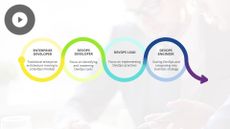Final Exam: SRE DevOps Engineer
DevOps
| Intermediate
- 1 video | 32s
- Includes Assessment
- Earns a Badge
Final Exam: DevOps Engineer will test your knowledge and application of the topics presented throughout the DevOps Engineer track of the Skillsoft Aspire Network Admin to Site Reliability Engineer Journey.
WHAT YOU WILL LEARN
-
Differentiate between simple and complex releasesprovide an overview of containersprovide an overview of release engineeringprovide an overview of release management and recognize its key termsrecognize how to automate tasks such as patching and windows updatinglist the goals of writing a post-mortem such as documenting the incident, root causes, and preventative actionsdescribe the release management cycle and each step in the cyclelist the four major principles of release engineering - self-service model, high velocity, hermetic builds, and enforcement of policies and proceduresprovide an overview of setting up a bulk enrollment of devices to be managed by the mobile device managementdefine the concept of software complexityrecognize how to use jenkins pipeline to implement and integrate continuous delivery pipelinesrecognize ways to determine software usage difficulty, e.g., is it functional and usable?provide examples of a poor bad post-mortem including potential areas to improve such as missing context, omitted details, missing action items, finger-pointing, animated languagerecognize how to use powershell for automation tasks in windowsrecognize the value of collaboration and knowledge sharing throughout the post-mortem workflowdifferentiate between containers and virtual machines and list container benefits such as consistent environment, isolation, run anywhererecognize how simple systems and software are easy to understand, maintain, and testdescribe the importance of continuous testing as it relates to the rapid release modeloutline software development stability and how it relates to sresprovide an overview of how automation has evolved at a company such as googleidentify how apis can lead to a path of simplicityprovide an overview of the release management processoutline software development agility and how it relates to sresrecognize when to implement a public cloud model and list key advantages for sresprovide an overview of branching as it relates to the rapid release modelprovide an overview of software as a solution (saas) and list key advantages for sresprovide an overview of kubernetesprovide an overview of dockeridentify when to implement a public cloud model and list key advantages for sresprovide an overview of infrastructure as a service (iaas) and list key advantages for sres
-
list the advantages of using a hybrid cloud model and list key advantages for sresdescribe how automation can reduce the meantime to repair for common faultsrecognize how to automate active directory user creation and user provisioninglist windows features that can automate aspects of software rollouts such as windows deployment services and volume activation management toolprovide an overview of a premortem approach including its benefitsdescribe how automation consistency can add valuerecognize the benefits of implementing a content as a service (caas) solutiondifferentiate between release engineering and release managementprovide an overview of the community cloud model and list key advantages for sresdifferentiate between continuous delivery, continuous deployment, and continuous integrationrecognize the importance of reviewing post-mortemslist considerations when implementing container securitydistinguish between complex and complicated codedifferentiate between complex and complicated codeoutline the importance of simple code, e.g., having fewer bugsrecognize how containers enable a more efficient continuous delivery system and why they are needed for sreunderstand differences between git/github and dvcs for version controllist potential challenges of automation such as integration, roi, complexity, and securitylist common challenges surrounding release managementrecognize how to do a premortem on a project as well as best practices to followprovide an overview of the private cloud modelprovide an overview of the platform as a service (paas) and list key advantages for sresdifferentiate between git and github and recognize how they can be used for revision control and to support the collaborative developmentdifferentiate between scripts and programs as they relate to automationrecognize the importance of sharing post-mortems as widely as possibledemonstrate how to use kubernetes to deploy applications with high availability, scalability, and resiliencerecognize key steps and factors of a code reviewdescribe continuous integration with dockerprovide an overview of blameless post-mortemsdifferentiate between essential complexity vs. accidental complexity and recognize how simple, "boring" software is ideal
EARN A DIGITAL BADGE WHEN YOU COMPLETE THIS COURSE
Skillsoft is providing you the opportunity to earn a digital badge upon successful completion on some of our courses, which can be shared on any social network or business platform.
Digital badges are yours to keep, forever.


